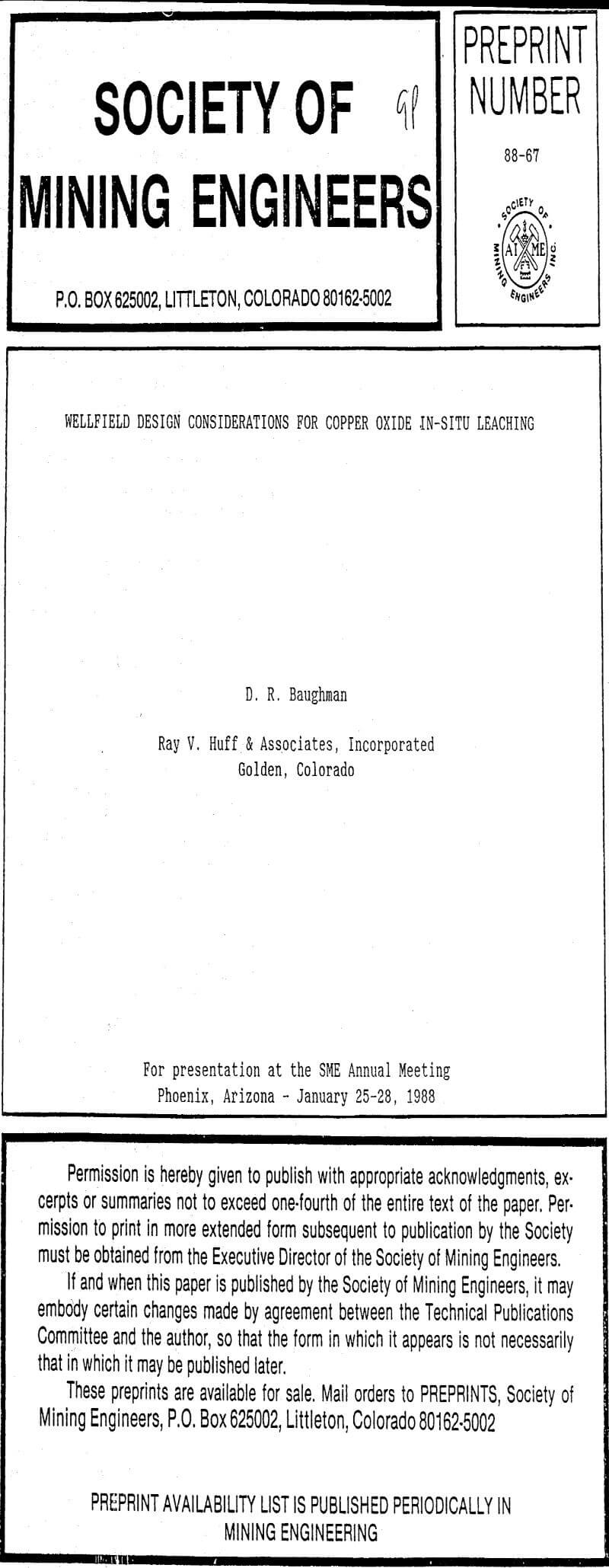Table of Contents
Copper oxide deposits that may be considered for in situ leaching exist in unique geologic settings, different from uranium deposits. A large number of interrelated factors must be considered in wellfield design. Many of these factors are hard to quantify and are directly related to geologic features of the orebody. This paper discusses some of the important factors in wellfield design and suggests an outline for a design procedure.
Components of Wellfield Design
The following can be considered the major component parts of the design:
- Well completion technique
- Pattern type
- Flowrate
- Copper recovery (percentage)
- Cu loadings
- Reagent consumption
- Pattern life
- Well spacing
Geological Considerations
In the orebodies of interest, copper minerals generally exist as fracture fillings, paint, and impregnations in fractured crystalline rocks. Chrysocolla is the common ore mineral, with brochantite, atacamite and other “oxides” occurring in significant quantities at some locations. The deposit genesis is thought to be the result of precipitation of copper minerals from solutions passing through the fracture controlled permeability.
From a hydrological point of view, copper oxide deposits are structurally discontinuous; dikes, faults, clay zones and other features are common. While uranium sandstone deposits mined by in situ leaching are vertically confined by low permeability strata, many copper deposits lack these features. Copper oxide deposits are far from isotropic.
Well Completion Methods
One early decision in the wellfield design is the choice of well completion techniques. A well completion for radial flow is one method which may be used. This is the technique normally employed for uranium leaching. In this method the well is simply perforated or a well screen installed through all or part of the vertical interval of interest. Because of the low permeability in many copper oxide deposits, this method of completion may result in insufficient flow for good economics.
In low permeability rock a second completion method may be considered. In this method, large radius propped hydraulic fractures are installed in adjacent wells. The fractures act as planar conduits for fluid flow when the fracture kh (permeability-thickness product) is much greater than that of the ore interval. The optimal case is parallel horizontal fractures which often occur at shallow depths (less than 1000 ft below surface).
For the case of axial flow leaching, the 5-spot pattern is likely to be best. Assuming horizontal fractures, this pattern provides good fracture overlap, yet the number of fractures required would be small. The 4-spot might also be considered, but the fracture overlap would not be as complete. Patterns requiring more holes would achieve only marginally greater fracture overlap at a much greater cost in the number of fractures and wells.
Copper Recovery and Sweep Efficiency
The overall economics of the method are greatly dependent on the percent recovery of copper from the patterns. A useful method of quantifying the recovery is to estimate it as two component parts:
Soluble recovery is the fraction of total copper (whether reported as “acid soluble” or “total” in assaying) that is recovered from small ore samples, such as a size used for core or column leaching tests. Leaching tests are conducted for a long enough time to represent actual exposure to lixiviant during mining or for long enough to project copper recovery for this period. Copper recovery may be less than total because of:
- The presence of refractory copper minerals such as sulfide, wad, chalcedony, or ion exchangers such as clay and zeolite.
- Copper minerals blinded, or reached so slowly by diffusion of reagents that recovery is not obtained in the time period for leaching.
For more accurate estimates, a field leaching test is the preferred approach. Still, the assumption must be made that the ore zone used in such a test is representative of the whole orebody.
If radial flow is used for leaching the concept of partially completing the ore interval in sequential steps might be used to obtain better recovery. The ore interval could be perforated and leached in stages, starting a the bottom and working upward. Although better overall recovery might be achieved, the time for leaching would be much greater.
Copper Loadings and Reagent Consumption
In the case of acid leaching, it is very important that the residence, time of solutions in the well pattern is long enough to consume most of the acid. Acid in the produced solutions will result in poor equilibrium for solvent extraction. A well spacing that is small relative to the flow rate, or short circuiting which might result from permeability anisotropy are potential causes.
Some of the copper minerals occur in the fluid flow paths that comprise the permeability. Leaching of these minerals will occur immediately upon contact with acid. Copper minerals not occurring in the fluid flow paths will be more slowly leached by diffusion. Acid traveling from injector to producer is depleted by the reaction with both copper minerals and gangue minerals.
Some idea of acid consumption and copper loadings can be obtained from column and core leaching tests. However in using such information to predict in situ consumption and loadings, the following considerations apply:
- Diffusion distances to copper minerals will be different.
- Sweep will occur through barren or depleted rock which is not well represented by column and core leaching.
- The ratio of copper minerals to gangue on flow surfaces may not be well represented.

